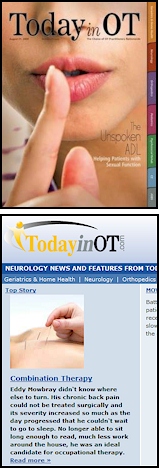 |
|
|
|||||||
|
However, at his first appointment with Sheri Barnes, OTR/L, MAc, an occupational therapist, massage therapist, and acupuncturist in Annapolis, Md., the pain was too severe for even rudimentary OT. Fortunately for Mowbray, Barnes had the perfect workaround: acupuncture. Spiking Interest Using acupuncture
for pain intervention, Barnes was able to maximize Mowbray’s
progress in OT. Needle in the
Haystack The idea that acupuncture is simply about sticking patients with needles is a common misconception. Heat, laser, acupressure, and beads also are used. Acupuncture is about understanding and helping a patient on multiple levels. “Adding acupuncture to your resume isn’t as simple as taking a few continuing education classes and thinking you can treat the complex acupuncture cases OTs are likely to encounter,” says Malina Chin, OTR/L, MSOM, LAc, an OT and acupuncturist at Vital Points Therapy in Libertyville, Ill. “Not only is a four-year master’s degree program required, but acupuncturists must also pass a national board test and be certified by the National Certification Commission for Acupuncture and Oriental Medicine. In addition, a license is required in most states.” Although practitioners such as Barnes and Chin routinely can work acupuncture into an OT plan, most often acupuncture is the last thing to be considered, if it is thought about at all. Sometimes primary care physicians refer patients, or therapists might try it as a last resort for a patient whose progress has plateaued. When a practice offers OT, PT, and acupuncture services, then acupuncture can be automatically included in the therapeutic arsenal. “Most people come in for one service and then find out about the other,” says Marcie Huffman, the billing administrator at the Center for Occupational and Environmental Neurology, in Lutherville, Md., who also handles insurance claims for Barnes. “A lot of people have heard about the benefits of acupuncture and are very interested when they find out that the same person can perform both services.” Putting the
Needle on the Record “More insurance
providers are covering alternative care, although Medicare still
considers acupuncture experimental and hence does not cover it,”
says Rebecca Jacobson, the office manager for Integrated PT, in
Klamath Falls, Ore. “Work-comp and automobile accident insurances
will pay for acupuncture treatments, and many Blue Cross and private
health insurance plans cover 80% to 100% with a small copay.” “The majority of our clients are physical therapy patients, and many of them get acupuncture as part of their treatment plan,” Jacobson says. “Therapists often report that these patients obtain a faster and more complete recovery from biomechanical dysfunctions, particularly if they were incurred in motor vehicle or other traumatic accidents.” “OT and acupuncture complement each other because they are both holistic and integrative approaches to health and wellness,” Chin says. “An OT trained as an acupuncturist has multiple avenues to improve the patient’s comfort, neuroplasticity, and ability to heal.” Ceri Usmar is a medical writer for the Gannett Healthcare Group. Article Link:http://news.todayinot.com/article/20090831/TODAYINOT010302/90828010 To
schedule an Annapolis
Acupuncture, Annapolis
Massage or Occupational
Therapy appointment with
Sheri Barnes, please use the
online contact form on this web site or contact Sheri
by telephone at 443-924-6363. |
|||||||
|
Sheri
Barnes
The Center Annapolis 1610 West Street, Suite 201 Annapolis, Maryland 21401 Telephone: 443-924-6363 |
|||||||
 Eddy
Mowbray didn’t know where else to turn. His chronic back pain
could not be treated surgically and its severity increased so much
as the day progressed that he couldn’t wait to go to sleep.
No longer able to sit long enough to read, much less work around
the house, he was an ideal candidate for occupational therapy.
Eddy
Mowbray didn’t know where else to turn. His chronic back pain
could not be treated surgically and its severity increased so much
as the day progressed that he couldn’t wait to go to sleep.
No longer able to sit long enough to read, much less work around
the house, he was an ideal candidate for occupational therapy.
